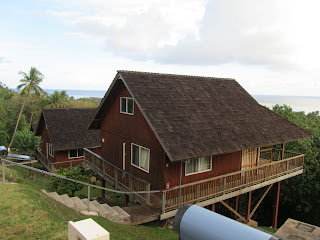I suppose I can't dive right into this post without acknowledging the extraordinary tardiness of it's presentation. Yes, I'm really lame, this is something we can all agree on. Now that that's out of the way, lets talk about our experience at the Keys Marine Lab (KML) in the Florida Keys after the Bioblitz in Biscayne Bay.
First off, the facility is great, there are dry labs, a wet lab, water tables (for keeping things alive), ample dorm space, and many other sciencey amenities including a boat complete with captain/dive master for diving or snorkeling. In the morning we would usually split into two groups one going out on the boat and the other doing shore-based collecting. Here are Gustav and Nat discussing strategy with the captain.

As far at the boat activities went, this strategy involved snorkeling, diving, and plankton tows. Because this was my first opportunity to use my AAUS Science Diver certification for actual collecting in the field I was pretty excited. I was also pretty inept. We'd all pile back into the boat after the air started running low, then while we were waiting for Gustav, who enters a presumably anaerobic state involving extremely low air consumption while diving, we would compare our finds of the dive. This Petrochirus diogenes was one of them.

I invariably lacked the collection skills of the more experienced among us (i.e. nearly everyone else) but I never came back completely empty-handed. And not only because my partner/dive buddy was the intrepid Sarah who had developed mad critter-spotting skills during her time in Moorea. Here she is on a snorkel excursion collecting some sargassum to be examined for critters.

The examining part looks like this.

Ok, maybe Hsiu is examining. The wet lab with its water tables and work space was where the animals were brought and sorted. This was also where sargassum was picked through and chunks of coral rubble were cracked open to reveal the creatures within. I think Nat is taking something from the water table back to the dry lab to be processed. The dry lab was a hive of activity. As earlier at Bioblitz, and as is usual in general in the field, the animals are anesthitized, photographed, and subsampled. There is also someone manning the computer and entering the animals into a spreadsheet along with the location they were found and their taxonomic ID. Here are Gustav and Anne DuPont consulting over an ID. Jenna is subsampling, and Francois is at the photo station. Since I don't see anyone next to Jenna where the computer person usually sat, I'm going to assume that it was me, who paused ever-so-briefly to take this picture.

After a long day of collecting and processing we'd haul our carcasses up to the dorm for dinner. Carole even made us some brownies to keep our energy and spirits high. Don't George, John, and Anne look revitalized?

In all, it was a very fun and productive trip. As we aim to increase our knowledge of the Florida fauna, we will hopefully be spending more time at KML in the future.
(Thanks to Carole Marshall and Anne DuPont for the crab picture and the brownie picture!)
 For one of our trips, Vetea (who lives and works here) took John, Yasunori, and I to look for terrestrial and freshwater molluscs in the area around Afareaitu Waterfall and the stream it feeds. The foliage was very dense in places, and we hiked around for about 4 hours fighting our way uphill through the vegetation.
For one of our trips, Vetea (who lives and works here) took John, Yasunori, and I to look for terrestrial and freshwater molluscs in the area around Afareaitu Waterfall and the stream it feeds. The foliage was very dense in places, and we hiked around for about 4 hours fighting our way uphill through the vegetation. But we did eventually make it to the waterfall.
But we did eventually make it to the waterfall. Where we did some collecting around the pool at the base. Yasunori has a special interest in the nerite group of freshwater snails. He even found one that he had described as a species eight years ago.
Where we did some collecting around the pool at the base. Yasunori has a special interest in the nerite group of freshwater snails. He even found one that he had described as a species eight years ago. While we were poking around the waterfall several more groups came and went, which was surprising considering how much of an effort it took us to get there. Then we realized there was a trail, which we weren't too proud to take on the way back to the car. Taking the trail down did nothing to diminish my sense of smug superiority over those who had taken the trail both ways!
While we were poking around the waterfall several more groups came and went, which was surprising considering how much of an effort it took us to get there. Then we realized there was a trail, which we weren't too proud to take on the way back to the car. Taking the trail down did nothing to diminish my sense of smug superiority over those who had taken the trail both ways! 

















